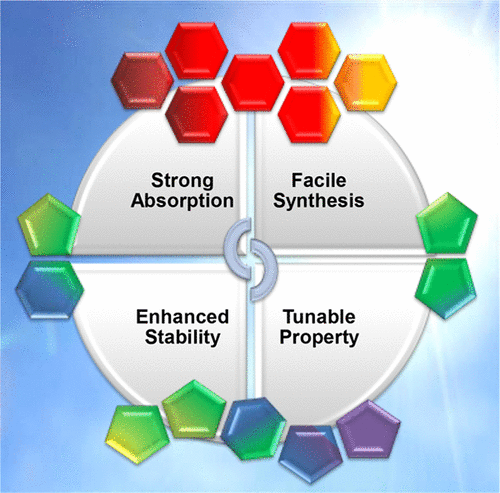当前位置:
X-MOL 学术
›
Chem. Rev.
›
论文详情
Our official English website, www.x-mol.net, welcomes your
feedback! (Note: you will need to create a separate account there.)
Nonfullerene Acceptor Molecules for Bulk Heterojunction Organic Solar Cells
Chemical Reviews ( IF 51.4 ) Pub Date : 2018-03-20 00:00:00 , DOI: 10.1021/acs.chemrev.7b00535 Guangye Zhang 1, 2 , Jingbo Zhao 1 , Philip C. Y. Chow 1, 2 , Kui Jiang 1, 2 , Jianquan Zhang 1, 2 , Zonglong Zhu 1 , Jie Zhang 3 , Fei Huang 3 , He Yan 1, 2, 3
Chemical Reviews ( IF 51.4 ) Pub Date : 2018-03-20 00:00:00 , DOI: 10.1021/acs.chemrev.7b00535 Guangye Zhang 1, 2 , Jingbo Zhao 1 , Philip C. Y. Chow 1, 2 , Kui Jiang 1, 2 , Jianquan Zhang 1, 2 , Zonglong Zhu 1 , Jie Zhang 3 , Fei Huang 3 , He Yan 1, 2, 3
Affiliation

|
The bulk-heterojunction blend of an electron donor and an electron acceptor material is the key component in a solution-processed organic photovoltaic device. In the past decades, a p-type conjugated polymer and an n-type fullerene derivative have been the most commonly used electron donor and electron acceptor, respectively. While most advances of the device performance come from the design of new polymer donors, fullerene derivatives have almost been exclusively used as electron acceptors in organic photovoltaics. Recently, nonfullerene acceptor materials, particularly small molecules and oligomers, have emerged as a promising alternative to replace fullerene derivatives. Compared to fullerenes, these new acceptors are generally synthesized from diversified, low-cost routes based on building block materials with extraordinary chemical, thermal, and photostability. The facile functionalization of these molecules affords excellent tunability to their optoelectronic and electrochemical properties. Within the past five years, there have been over 100 nonfullerene acceptor molecules synthesized, and the power conversion efficiency of nonfullerene organic solar cells has increased dramatically, from ∼2% in 2012 to >13% in 2017. This review summarizes this progress, aiming to describe the molecular design strategy, to provide insight into the structure–property relationship, and to highlight the challenges the field is facing, with emphasis placed on most recent nonfullerene acceptors that demonstrated top-of-the-line photovoltaic performances. We also provide perspectives from a device point of view, wherein topics including ternary blend device, multijunction device, device stability, active layer morphology, and device physics are discussed.
中文翻译:

用于整体异质结有机太阳能电池的非富勒烯受体分子
电子给体和电子受体材料的体-异质结共混物是溶液加工的有机光伏器件中的关键组分。在过去的几十年中,p型共轭聚合物和n型富勒烯衍生物分别是最常用的电子给体和电子受体。尽管器件性能的大部分进步来自于新的聚合物供体的设计,但富勒烯衍生物几乎仅被用作有机光伏中的电子受体。近来,非富勒烯受体材料,特别是小分子和低聚物已经出现,作为替代富勒烯衍生物的有前途的替代品。与富勒烯相比,这些新受体通常由多种低成本路线合成而成,这些路线基于具有出色化学,热学,和光稳定性。这些分子的轻松功能化为其光电和电化学特性提供了出色的可调性。在过去的五年中,已经合成了100多个非富勒烯受体分子,非富勒烯有机太阳能电池的功率转换效率从2012年的约2%到2017年的13%显着提高。描述分子设计策略,深入了解结构与性质之间的关系,并突出显示该领域面临的挑战,重点放在展示了最先进光伏性能的最新非富勒烯受体上。我们还从设备的角度提供了一些观点,其中的主题包括三元混合设备,多结设备,设备稳定性,
更新日期:2018-03-20
中文翻译:

用于整体异质结有机太阳能电池的非富勒烯受体分子
电子给体和电子受体材料的体-异质结共混物是溶液加工的有机光伏器件中的关键组分。在过去的几十年中,p型共轭聚合物和n型富勒烯衍生物分别是最常用的电子给体和电子受体。尽管器件性能的大部分进步来自于新的聚合物供体的设计,但富勒烯衍生物几乎仅被用作有机光伏中的电子受体。近来,非富勒烯受体材料,特别是小分子和低聚物已经出现,作为替代富勒烯衍生物的有前途的替代品。与富勒烯相比,这些新受体通常由多种低成本路线合成而成,这些路线基于具有出色化学,热学,和光稳定性。这些分子的轻松功能化为其光电和电化学特性提供了出色的可调性。在过去的五年中,已经合成了100多个非富勒烯受体分子,非富勒烯有机太阳能电池的功率转换效率从2012年的约2%到2017年的13%显着提高。描述分子设计策略,深入了解结构与性质之间的关系,并突出显示该领域面临的挑战,重点放在展示了最先进光伏性能的最新非富勒烯受体上。我们还从设备的角度提供了一些观点,其中的主题包括三元混合设备,多结设备,设备稳定性,











































 京公网安备 11010802027423号
京公网安备 11010802027423号